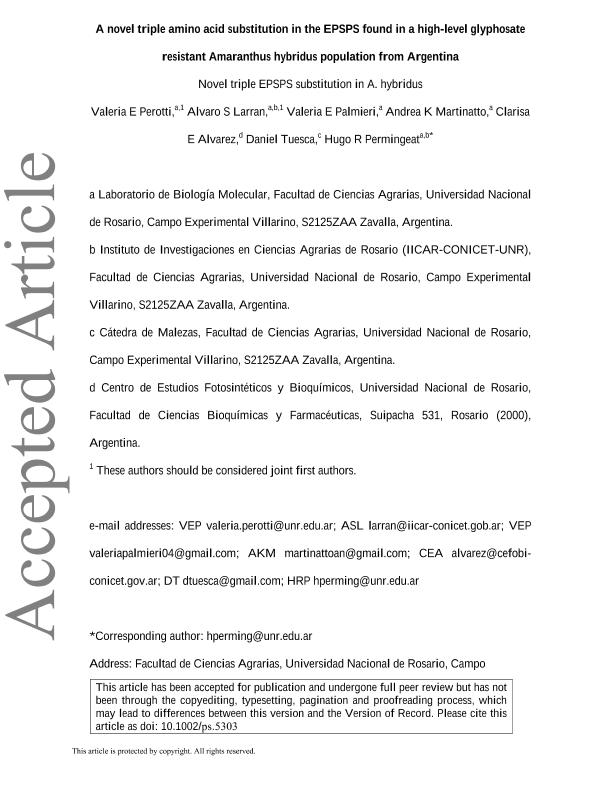Artículo
A novel triple amino acid substitution in the EPSPS found in a high-level glyphosate-resistant Amaranthus hybridus population from Argentina
Perotti, Valeria Elisa ; Larran, Alvaro Santiago
; Larran, Alvaro Santiago ; Palmieri, Valeria Esther
; Palmieri, Valeria Esther ; Martinatto, Andrea Karina
; Martinatto, Andrea Karina ; Alvarez, Clarisa Ester
; Alvarez, Clarisa Ester ; Tuesca, Daniel; Permingeat, Hugo Raúl
; Tuesca, Daniel; Permingeat, Hugo Raúl
 ; Larran, Alvaro Santiago
; Larran, Alvaro Santiago ; Palmieri, Valeria Esther
; Palmieri, Valeria Esther ; Martinatto, Andrea Karina
; Martinatto, Andrea Karina ; Alvarez, Clarisa Ester
; Alvarez, Clarisa Ester ; Tuesca, Daniel; Permingeat, Hugo Raúl
; Tuesca, Daniel; Permingeat, Hugo Raúl
Fecha de publicación:
05/2019
Editorial:
John Wiley & Sons Ltd
Revista:
Pest Management Science
ISSN:
1526-498X
Idioma:
Inglés
Tipo de recurso:
Artículo publicado
Clasificación temática:
Resumen
Background: The evolution of herbicide-resistant weeds is one of the most important concerns of global agriculture. Amaranthus hybridus L. is a competitive weed for summer crops in South America. In this article, we intend to unravel the molecular mechanisms by which an A. hybridus population from Argentina has become resistant to extraordinarily high levels of glyphosate. Results: The glyphosate-resistant population (A) exhibited particularly high parameters of resistance (GR 50 = 20 900 g ai ha −1 , Rf = 314), with all plants completing a normal life cycle even after 32X dose application. No shikimic acid accumulation was detected in the resistant plants at any of the glyphosate concentrations tested. Molecular and genetic analyses revealed a novel triple substitution (TAP-IVS: T102I, A103V, and P106S) in the 5-enol-pyruvylshikimate-3-phosphate synthase (EPSPS) enzyme of population A and an incipient increase on the epsps relative copy number but without effects on the epsps transcription levels. The novel mechanism was prevalent, with 48% and 52% of the individuals being homozygous and heterozygous for the triple substitution, respectively. In silico conformational studies revealed that TAP-IVS triple substitution would generate an EPSPS with a functional active site but with an increased restriction to glyphosate binding. Conclusion: The prevalence of the TAP-IVS triple substitution as the sole mechanism detected in the highly glyphosate resistant population suggests the evolution of a new glyphosate resistance mechanism arising in A. hybridus. This is the first report of a naturally occurring EPSPS triple substitution and the first glyphosate target-site resistance mechanism described in A. hybridus.
Archivos asociados
Licencia
Identificadores
Colecciones
Articulos(CCT - ROSARIO)
Articulos de CTRO.CIENTIFICO TECNOL.CONICET - ROSARIO
Articulos de CTRO.CIENTIFICO TECNOL.CONICET - ROSARIO
Articulos(CEFOBI)
Articulos de CENTRO DE EST.FOTOSINTETICOS Y BIOQUIMICOS (I)
Articulos de CENTRO DE EST.FOTOSINTETICOS Y BIOQUIMICOS (I)
Articulos(IICAR)
Articulos de INST. DE INVESTIGACIONES EN CIENCIAS AGRARIAS DE ROSARIO
Articulos de INST. DE INVESTIGACIONES EN CIENCIAS AGRARIAS DE ROSARIO
Citación
Perotti, Valeria Elisa; Larran, Alvaro Santiago; Palmieri, Valeria Esther; Martinatto, Andrea Karina; Alvarez, Clarisa Ester; et al.; A novel triple amino acid substitution in the EPSPS found in a high-level glyphosate-resistant Amaranthus hybridus population from Argentina; John Wiley & Sons Ltd; Pest Management Science; 75; 5; 5-2019; 1242-1251
Compartir
Altmétricas



